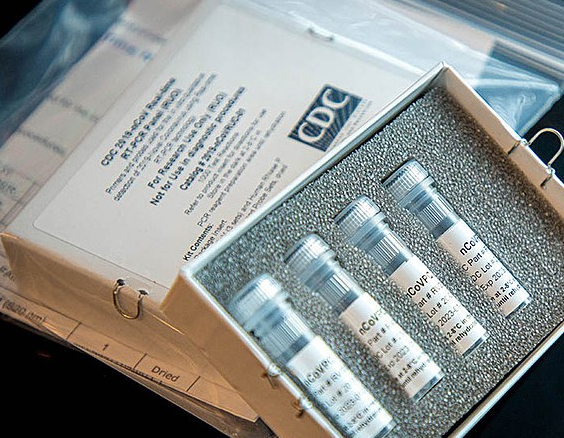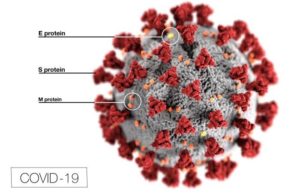April 15, 2020
Richard Pilch
This article is part of World War “V”: The COVID-19 Pandemic, a collection of all CNS COVID-19-related articles.
On April 14, 2020, the Washington Post reported early details of the White House plan to reopen the U.S. The public health component of the plan includes three phases: (1) public communication and community readiness assessment prior to 1 May; (2) ramping up capacities from 1 to 15 May; and (3) easing restrictions based on COVID-19 risk on a location-by-location basis. As other experts have astutely pointed out, a key challenge to meeting this aggressive timeline is the lack of a proof-of-concept stage where the above steps are successfully carried out in a test location. Our analysis further indicates that the plan does not appropriately account for current limitations in testing, contact tracing, and healthcare capacities. This article lays out our recommended approach to move forward within these well-documented limitations.

Covid19 Test Kit, Source: CDC via Wikimedia Commons
The concept of this article is simple – while the U.S. needs to move forward against COVID-19, we only have what we have. The many U.S. recovery strategies proposed to date rightly emphasize testing, contact tracing, and healthcare capacity, drawing lessons from countries such as South Korea that have had comparable success responding to COVID-19. [1] But to be executable, a strategy must take into account our current limitations as a nation: (1) we do not yet have the testing capacity we need; (2) we do not yet have the contact tracing capacity we need; and (3) we do not yet have the healthcare capacity we need.
“Test, Flex, and Scale” is a three-step plan designed to overcome these limitations, as follows:
- Test
I have been unable to identify or assemble a real-time dashboard tracking our current and projected testing capacity, and maybe that’s for the best. What we need to know is that we do not currently have the PPE, swabs, test kits, reagents, or consumables to test the entire population for SARS-CoV-2 infection, let alone test the entire population many times over as some strategies suggest. What we do have is an ability to test select populations for infection right now, while we are scaling our test capacity to meet the ultimate goal of testing everyone (see below). Part of that immediate ability must be directed to meet the healthcare community’s testing needs; the rest should be directed toward the testing of sentinel groups that provide a meaningful indicator of disease activity in their representative populations. This is a long-time public health surveillance strategy that is also used to counter plant and animal diseases: for example, we monitor sentinel soybean plots to detect a devastating plant disease called soybean rust before it spreads in the surrounding area. [2] For COVID-19, sentinel groups should comprise individuals exposed to large, localized populations: for example, TSA workers at a given airport, bus drivers, supermarket and pharmacy workers, delivery persons, drive-through tellers, etc. If sentinel testing indicates that the virus is spreading in a given population, we move on to Step 2: Flex. - Flex
The next step is to flexibly surge public health and medical resources to areas of need. [3] Such resources include public health personnel for contact tracing and testing; [4] additional test kits and supplies; and healthcare personnel, equipment, and infrastructure. While these resources aren’t currently available at the scale needed to create a uniform national defense posture (see below), we have enough resources nationwide to manage pockets of infection as they occur by rapidly flexing resources from areas of stability/surplus to areas of need. As resources are flexed, shelter-in-place/stop movement orders for non-critical workers must be issued to contain spread in the affected population and protect stable areas from which resources have been diverted. Flexing resources in this manner reduces risk to the U.S. population as a whole, but depends on Step 3: Scale to protect both affected and stable areas over time. - Scale
The last step is to rapidly allocate additional resources as they become available. We are accelerating the production and sourcing of key assets, including PPE, swabs, test kits, reagents, consumables, and ventilators. We are rigorously testing treatments such as convalescent plasma, remdesivir, and other options. We are driving toward a vaccine. We are recruiting and training additional public health and healthcare personnel. We are identifying and preparing additional healthcare facilities. Each of these capabilities is a potential game-changer that must be aggressively rolled into our response in real-time, first to reinforce flexed assets, then to backfill them, and finally to fortify broader swathes of the population up to and including the nation as a whole, our neighbors and Allies, and the global community.
To be clear, it would not be possible to consider Test, Flex, and Scale at this juncture without our nation’s many initial weeks of social distancing to both mitigate COVID-19 spread and preserve healthcare capacity. Thanks to those efforts, however, we have put ourselves in a place where our constrained resources are nonetheless sufficient to begin reopening the country if allocated appropriately.
If we implement Test, Flex, and Scale on May 1, 2020, we will have enough sentinel testing data by June 1 to make data-driven decisions on where it is safe to begin easing restrictions. As initial metrics, we recommend that in areas where sentinel testing shows 14 days of no new cases (which represents the maximum incubation period in the majority of cases), corresponding populations can incrementally reopen – low risk groups first (while still practicing risk reduction measures such as physical distancing, hand hygiene, N95 mask use, limiting mass gatherings, etc.) and expanding from there. Where sentinel testing indicates that the virus is spreading, full restrictions should remain in place.
Ultimately, the decision would be left to the States regarding when to formally ease restrictions based on corresponding sentinel testing. But Test, Flex, and Scale underscores the reality that we are one people, and only with a unified national approach will we be able to safely and smartly reopen the country in the coming weeks.
Dr. Richard Pilch is Director of the Chemical and Biological Weapons Nonproliferation Program, James Martin Center for Nonproliferation Studies, Middlebury Institute of International Studies at Monterey.
See Also
 World War “V”: The COVID-19 Pandemic
World War “V”: The COVID-19 Pandemic
A collection of all CNS COVID-19-related articles
Notes
[1] See for example: https://www.aei.org/research-products/report/national-coronavirus-response-a-road-map-to-reopening/; https://www.americanprogress.org/issues/healthcare/news/2020/04/03/482613/national-state-plan-end-coronavirus-crisis/; https://santafe.edu/news-center/news/transmission-t-007-danielle-allen-e-glen-weyl-and-rajiv-sethi-how-reduce-covid-19-mortality-while-easing-economic-decline; https://www.nejm.org/doi/full/10.1056/NEJMe2007263; https://www.washingtonpost.com/health/2020/04/10/contact-tracing-coronavirus-strategy/; https://www.nytimes.com/2020/04/12/opinion/joe-biden-coronavirus-reopen-america.html
[2] See for example: https://news.ca.uky.edu/article/sentinel-plot-network-aid-early-detection-soybean-rust
[3] See for example: https://nonproliferation.org/regional-pairing-to-mitigate-overwhelmed-healthcare-systems/
[4] See for example: https://www.centerforhealthsecurity.org/our-work/pubs_archive/pubs-pdfs/2020/a-national-plan-to-enable-comprehensive-COVID-19-case-finding-and-contact-tracing-in-the-US.pdf; https://www.npr.org/sections/health-shots/2020/04/10/831200054/cdc-director-very-aggressive-contact-tracing-needed-for-u-s-to-return-to-normal
